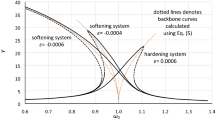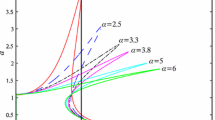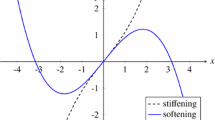Abstract
This work presents an analytic technique aimed at designing the external excitation of linear and nonlinear oscillators so that a prescribed form of their steady-state response can be achieved. The technique exploits the exact analytic solutions of the oscillator response having quadratic and/or cubic nonlinearities. Both single-frequency and multi-frequency responses are considered. Examples of possible applications are provided in terms of virtual experiments.
Access provided by Autonomous University of Puebla. Download conference paper PDF
Similar content being viewed by others
Keywords
15.1 Introduction
Quadratic and cubic geometric nonlinearities appear in a variety of physical and engineering oscillatory systems. Quadratic nonlinearities are referred to as Helmholtz-type nonlinearities, since it was Helmholtz, who first postulated that the eardrum behaves as an asymmetric oscillator with a restoring force including a linear and a quadratic geometric term [1]. Cubic nonlinearities are referred to as Duffing-type nonlinearities, and are named after Duffing, who investigated pendula with restoring forces containing cubic nonlinearities [2]. Analogously, oscillators that comprise both quadratic and cubic stiffness nonlinearities are referred to as Helmholtz-Duffing oscillators.
During the previous decades, many perturbation and non-perturbation techniques have been developed to obtain the free and forced responses of Helmholtz, Duffing and Helmholtz-Duffing oscillators. All of these techniques are based on approximations [1, 3]. However, recent investigations have considered strategies based on the exact solutions of the steady-state response of nonlinear oscillators, and the design of external excitations to generate them. The idea of a specially designed external excitation to generate a specific form of steady-state response dates back to Hsu [4]. Such an idea has been recently extended to forced one-degree-of-freedom undamped oscillators with cubic or quadratic nonlinearities [5], purely nonlinear oscillators [6], multi-degree-of-freedom purely nonlinear chains [7], as well as to a variety of damped nonlinear oscillators [8, 9].
This study aims at extending the methodology presented in [9], which is limited to oscillators containing a symmetric form of stiffness nonlinearity, to oscillators containing quadratic nonlinearities as well, thus leading to asymmetric force-deflection curves.
15.2 Theoretical Approach
15.2.1 Free Oscillators
The equation of motion of a Helmholtz-Duffing oscillator can be written down as
where c1, c2 and c3 are all assumed to be equal or greater than zero. The initial conditions are selected so that the initial velocity is assumed to be zero.
There is no exact solution for the response of the Helmholtz-Duffing oscillator, and the approximate solution for its motion contains odd and even harmonics [3]. However, the exact solution for the response of Helmholtz and Duffing oscillators does exist and is given below.
When \( c_{3} = 0 \), the exact solution for the Helmholtz oscillator includes the square of the Jacobi elliptic sn function [10] and can be written down as follows
where
Note that the Jacobi sn elliptic function has two arguments: the first is a function of the frequency ω, the second is the elliptic modulus k. For k = 0 the sn function turns into the sin function. It should be pointed out that the Helmholtz oscillator with positive coefficients has two equilibria: a center point at the origin and a saddle point at \( x = - \frac{{3c_{1} }}{{2c_{2} }} \). The separatrix that passes through the saddle point corresponds to k = 1 [10]. The phase trajectories that lie inside the separatrix are closed, and indicate the occurrence of periodic motion. Furthermore, the existence of the constant term in the solution given by Eq. (15.2) implies that the system oscillates around a non-trivial value. The frequency content can be determined based on the Fourier expansion [11, 12], where the sn function can be represented as a sum of odd harmonics of the sin function, as follows
where the coefficients SN are given by
\( K = K(k) \) is the complete elliptic integral of the first kind [11, 12], and \( q = q(k) \) is the so-called Nome, given by
The fact that the sn function appears as a squared function in Eq. (15.2) implies that the oscillatory response includes an offset and both odd and even harmonics.
When \( c_{2} = 0 \), Eq. (15.1) corresponds to the equation of motion of the Duffing oscillator, whose exact solution has the form of a Jacobi cn elliptic function
where
For positive coefficients, i.e. for hardening nonlinearity, such oscillator has one equilibrium, which is a center point at the origin. The frequency content can be determined from a Fourier expansion, which includes odd harmonics of the cos function as follows
and the coefficients CN are given by
When \( c_{2} = c_{3} = 0 \), Eq. (15.1) simplifies to a linear oscillator, having the well-known solution for motion given by
15.2.2 Forced Oscillators
Based on the previous discussion, it is possible to determine the exact solution for the steady-state response of a variety of damped and undamped linear and nonlinear oscillators governed by the following generalized equation of motion
Furthermore, it is possible to design the external excitation of such oscillators to achieve a desired form for their free response \( x_{r} (t) \), as discussed below.
15.2.2.1 Single-Harmonic Response
If it is desirable that the oscillator governed by Eq. (15.12) responds as a free linear oscillator, i.e. with a single harmonic as in Eq. (15.11), then this can be achieved with the external force having the following form
where E is a constant.
Using Eq. (15.11) as the desired response, the equation of motion can be written as
where \( \Omega = \sqrt {c_{1} - E} \), and \( c_{1} \ge E \).
On the one hand, equating \( c_{3} \) to zero and assuming \( E = 0 \), gives the equation of motion of an externally excited Helmholtz oscillator, whose steady-state response is harmonic. Such an oscillator is governed by:
On the other hand, equating \( c_{2} \) to zero in Eq. (15.14) and assuming \( E = 0 \), gives the equation of motion of the externally excited Duffing oscillator, whose steady-state response is also harmonic. Such an oscillator is governed by:
15.2.2.2 Multi-harmonic Response
The same methodology can be applied to design an external excitation for a nonlinear oscillator to make it respond as any other oscillator. Thus, assuming the external force in the form
Equation (15.12) becomes
If \( c_{3} = D \), then the system response has the form given by Eq. (15.2), where \( c_{2} \) in Eq. (15.3) is replaced by \( c_{2} - B,{\text{and}}\,c_{2} > B \). Similarly, for \( c_{2} = B \) and \( c_{3} > D \), the system response has the form given by Eq. (15.7), and \( c_{3} \) in Eq. (15.8) is replaced by \( c_{3} - D. \)
15.3 Numerical Simulations
To validate the previous theoretical considerations, virtual experiments [13] are performed on a mechanical model of the system illustrated in Fig. 15.1. The system consists of one mass m attached to three linear springs of stiffness k, geometrically arranged to achieve the desired stiffness nonlinearity.
In particular, a vertical linear spring is combined with two lateral linear springs, which incline as the oscillating mass moves. The static equilibrium position of the mass from the position where the lateral springs are horizontal is denoted by a, so that the natural spring length is \( l_{0} = \sqrt {a^{2} + b^{2} } \), where b is labeled in Fig. 15.1. A linear viscous damper c is introduced for dynamic purposes. The expression of the static force-deflection curve of the oscillator in Fig. 15.1 is
which can be expanded in Taylor series to the third term to give
It can be noted from Eq. (15.20) that when \( a = b/2 \), the system behaves as the Helmholtz oscillator, since the cubic stiffness coefficient becomes zero, and when a = 0 the system behaves as the Duffing oscillator, since the quadratic stiffness coefficient becomes zero.
Three virtual experiments are then performed on the Helmholtz, Duffing and Helmholtz-Duffing oscillator, respectively, and they are reported below.
15.3.1 Forced Helmholtz Oscillator
In this case, a representation of the system in its static equilibrium configuration is shown in Fig. 15.2a. The geometric system parameters are a = 0.1, b = 0.2, k = 100, c = 2, m = 1, so that \( {\varsigma } = 1 \), c1 = 140 and c3 = 480 in Eq. (15.15). The force-deflection curve given by Eq. (15.19) and its approximation in Eq. (15.20) are plotted in Fig. 15.2b. It can be seen that the Taylor series expansion is a good approximation in the displacement range from −0.1 to 0.1. The curve is clearly asymmetric.
The excitation given by Eq. (15.13), with c3 = 0 and E = 0 is applied to the oscillating mass, and is plotted in Fig. 15.3a with a solid line. The excitation is such that the displacement amplitude at the steady-state is 0.1. In Fig. 15.3a, a sinusoidal excitation with an amplitude equal to the first harmonic of the excitation in Eq. (15.13) is plotted as a dashed line. Figure 15.3b shows the Fourier coefficients of the two excitations plotted in Fig. 15.3a with a corresponding line style. Clearly, a second harmonic and an offset are evident from the solid line.
Helmholtz-like oscillator. a Force excitation and b corresponding Fourier coefficients; c displacement response and d corresponding Fourier coefficients. Force excitation according to Eq. (15.13) and corresponding response (solid line), harmonic excitation and corresponding response (dashed line)
Two virtual experiments are then carried out by exciting the system in Fig. 15.2a with the two excitations described above. The results are presented in Fig. 15.3c. It is noted that simulations run from the static equilibrium condition (i.e. \( x(t) = \dot{x}(t) = 0 \)), and after a transient, both responses reach a steady-state that is fairly harmonic. However, as noted in Fig. 15.3d, the Fourier coefficients of the displacement responses in Fig. 15.3c show that the specifically designed excitation in Eq. (15.13) significantly reduces the presence of the offset and also of the second harmonic in the response.
15.3.2 Forced Duffing Oscillator
In this case, a representation of system is shown in Fig. 15.4a. The system parameters are a = 0, b = 0.2, k = 100, c = 2, m = 1, so that \( {\varsigma } = 1 \), c1 = 100 and c3 = 2500 in Eq. (15.16). The force-deflection curve is plotted in Fig. 15.4b and it is now symmetric. Taylor series approximation holds, as in the previous section.
The force excitation given in Eq. (15.13), with c2 = 0 and E = 0 is plotted in Fig. 15.5a with a solid line, and a sinusoidal excitation with an amplitude equal to the first harmonic of the excitation in Eq. (15.13) is plotted as a dashed line. Figure 15.5b shows the Fourier coefficients of the two excitations plotted in Fig. 15.5a with a corresponding line style. Clearly, a third harmonic is evident from the solid line.
Duffing-like oscillator. a Force excitation and b corresponding Fourier coefficients; c displacement response and d corresponding Fourier coefficients. Force excitation according to Eq. (15.13) and corresponding response (solid line), harmonic excitation and corresponding response (dashed line)
Two virtual experiments are performed by exciting the system in Fig. 15.4a with the two excitations described above. The results are presented in Fig. 15.5c. It can be noted that after a transient, both responses reach a fairly harmonic steady-state. However, as noted in the close-up of Fig. 15.5d, the Fourier coefficients of the displacement responses in Fig. 15.5c show that the specifically designed excitation in Eq. (15.13) considerably reduces the presence of the third harmonic in the response.
15.3.3 Forced Helmholtz-Duffing Oscillator
In this case, a representation of the system is shown in Fig. 15.6a. The system parameters are a = 0.1, b = 0.2, k = 100, c = 2, m = 1, so that \( {\varsigma } = 1 \), c1 = 111.7647, c2 = 332.1799 and c3 = 1563.2 in Eq. (15.14). The asymmetric force-deflection curve is plotted in Fig. 15.6b, together with its Taylor series approximation.
The force excitation given by Eq. (15.13), with E = 0, is plotted in Fig. 15.7a with a solid line, and a sinusoidal excitation with an amplitude equal to the first harmonic of the excitation in Eq. (15.13) is plotted as a dashed line. Figure 15.7b shows the Fourier coefficients of the two excitations plotted in Fig. 15.7a. An offset, a second and a third harmonic are evident from the solid line.
Helmholtz-Duffing-like oscillator. a Force excitation and b corresponding Fourier coefficients; c displacement response and d corresponding Fourier coefficients. Force excitation according to Eq. (15.13) and corresponding response (solid line), harmonic excitation and corresponding response (dashed line)
Two virtual experiments are carried out as described earlier. The results are presented in Fig. 15.7c, where it is noted that both responses reach a steady-state which is again fairly harmonic. However, as noted in Fig. 15.7d, the Fourier coefficients of the displacement responses from Fig. 15.7c show that the specifically designed excitation in Eq. (15.13) significantly reduces the presence of the offset and of the second harmonic in the system response.
15.4 Conclusions
Oscillators with quadratic and/or cubic nonlinearities have been considered in this paper. An analytic technique has been presented to properly design a specific external excitation to make them respond as different desired free oscillators. The case where the response contains one single harmonic only, and the case where there is a multi-frequency response, have been considered. Virtual experiments have been performed on a mechanical assembly of the oscillator, and they have shown that the proposed technique can significantly reduce the presence of undesired harmonics in the oscillator response.
References
Kovacic, I., Brennan, M.J. (eds.): The Duffing Equations: Nonlinear Oscillators and their Behaviour. Wiley, Chichester (2011)
Duffing, G.: Erzwungene Schwingungen bei veränderlicher Eigenfrequenz und ihre technische Bedeutung, Heft 41/42. Vieweg, Braunschweig (1918) (in German)
Nayfeh, A.H., Mook, D.: Nonlinear Oscillations. Wiley, New York (1979)
Hsu, C.S.: On the application of elliptic functions in nonlinear forced oscillations. Q. Appl. Math. 17, 393–407 (1960)
Rakaric, Z., Kovacic, I., Cartmell, M.P.: On the design of external excitations in order to make nonlinear oscillators respond as free oscillators of the same or different type. Int. J. Nonlinear Mech. 94C, 323–333 (2017)
Kovacic, I.: On the response of purely nonlinear oscillators: an Ateb-type solution for motion and an Ateb-type external excitation. Int. J. Nonlinear Mech. 92, 15–24 (2017)
Kovacic, I., Zukovic, M.: Coupled purely nonlinear oscillators: normal modes and exact solutions for free and forced responses. Nonlinear Dyn. 87, 713–726 (2017)
Kovacic, I.: Externally excited undamped and damped linear and nonlinear oscillators: exact solutions and tuning to a desired exact form of the response. Int. J. Nonlinear Mech. 102, 72–81 (2018)
Kovacic, I., Gatti, G.: Some benefits of using exact solutions of forced nonlinear oscillators: theoretical and experimental investigations. J. Sound Vib. 436, 310–326 (2018)
Rand, R.H.: Using computer algebra to handle elliptic functions in the method of averaging. In: Noor, A.K., Elishakoff, I., Hulbert, G. (eds.) Symbolic Computations and Their Impact on Mechanics, vol. 205, pp. 311–326. American Society of Mechanical Engineers, PVP (1990)
Byrd, P., Friedman, M.: Handbook of Elliptic Integrals for Engineers and Scientists. Springer, Berlin (1954)
Abramowitz, M., Stegun, I.: Handbook of Mathematical Functions. Dover Publications, New York (1965)
Gatti, G., Brennan, M.J.: Inner detached frequency response curves: an experimental study. J. Sound Vib. 396, 246–254 (2017)
Acknowledgements
The first author acknowledges support of the Ministry of Education and Science of Serbia, grant ON174028.
Author information
Authors and Affiliations
Corresponding author
Editor information
Editors and Affiliations
Rights and permissions
Copyright information
© 2020 Springer Nature Switzerland AG
About this paper
Cite this paper
Kovacic, I., Gatti, G. (2020). Helmholtz, Duffing and Helmholtz-Duffing Oscillators: Exact Steady-State Solutions. In: Kovacic, I., Lenci, S. (eds) IUTAM Symposium on Exploiting Nonlinear Dynamics for Engineering Systems. ENOLIDES 2018. IUTAM Bookseries, vol 37. Springer, Cham. https://doi.org/10.1007/978-3-030-23692-2_15
Download citation
DOI: https://doi.org/10.1007/978-3-030-23692-2_15
Published:
Publisher Name: Springer, Cham
Print ISBN: 978-3-030-23691-5
Online ISBN: 978-3-030-23692-2
eBook Packages: EngineeringEngineering (R0)











